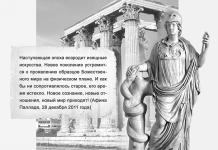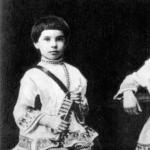The myth of the birth of Pallas Athena. - Goddess Athena and Erichthonius (Erechtheus). - The myth about the dispute between the goddess Athena and the god Poseidon. - Type and distinctive features of Pallas Athena. - Statue of Pallas Athena by Phidias. - Goddess Athena and god Eros. - The myth of the flute of the satyr Marcias. - Athena the worker: the myth of the Lydian Arachne. - Great Panathenaea.
The myth of the birth of Pallas Athena
One of the oldest Greek myths tells the following about the origin and birth of the goddess of wisdom. Pallas Athena(in Roman mythology - goddess Minerva) was the daughter of Zeus (Jupiter) and his first wife Metis (translated from ancient Greek as “meditation”). The goddess Metis predicted that she would first have a daughter and then a son, and that this son would be the ruler of the universe.
Zeus (Jupiter), frightened by such a prediction, turned to the goddess Gaia (Earth) for advice. Gaia advised Zeus to swallow Metis, which he did.
After some time, Zeus (Jupiter) felt a severe headache. It seemed to Zeus that his skull was ready to shatter into pieces. Zeus asked God (Vulcan) to split his head with an ax and see what was happening there. As soon as Hephaestus fulfilled his request, Pallas Athena, armed and in full bloom, emerged from the head of Zeus - “the mighty daughter of a mighty father,” as Homer usually calls the goddess Athena.
Several monuments of ancient art (among others, the Parthenon frieze, which no longer exists), depicted the birth of Pallas Athena.
Pallas Athena is, therefore, the personification of the divine reason and prudence of Zeus (Jupiter). Pallas Athena is a strong and warlike goddess, intelligent and judicious. Since the goddess Athena was born not from her mother, but directly from the head of Zeus (Jupiter), all female weaknesses are alien to Pallas Athena. The goddess Athena has a serious, almost masculine character; she is never embarrassed by the excitement of love and passion. Pallas Athena is an eternal virgin, the favorite of Zeus (Jupiter), his like-minded person, although sometimes, as, for example, in the Trojan War, the goddess Athena acts against the will of her father.
Pallas Athena has a healthy and clear view of humanity and willingly takes part in all life manifestations of people. Pallas Athena is always on the side of a just cause, helps brave heroes win victories over their enemies, is the patroness of Odysseus and Penelope, and the leader of Telemachus.
The goddess Athena personifies human culture. The goddess Athena invented many useful items, such as the plow and rake. Athena taught people how to harness oxen and made them bend their necks under the yoke. The myths of ancient Greece believe that Pallas Athena was the first to subdue a horse and turn it into a pet.
Pallas Athena taught Jason and his companions how to build the ship "Argo" and patronized the entire time their famous campaign continued.
Pallas Athena is the goddess of war, but she recognizes only a prudent war, waged according to all the rules of military art and having a specific goal. In this way, Pallas Athena differs from the god of war Ares (Mars), who enjoys the sight of blood and who loves the horrors and confusion of war.
The goddess Athena is everywhere a strict enforcer of laws, the patroness and defender of civil rights, cities and harbors. Pallas Athena has a keen eye. The poets of antiquity called the goddess Athena “blue-eyed, bright-eyed and far-sighted.”
The Areopagus was founded by Pallas Athena. The goddess Athena was revered as the patroness of musicians, artists and all artisans.
Goddess Athena and Erichthonius (Erechtheus)
When the goddess Gaia (Earth), having given birth to a son, Erichthonius (aka Erechtheus), from the god Hephaestus, abandoned him to his fate, Pallas Athena picked up Erichthonius and raised him. According to Greek myth, Erichthonius resembled one half of his body, namely its lower part, like a snake.
The goddess Athena, constantly busy with wars, put the child in a basket and entrusted Erichthonius to the daughters of Kekrops for a while, forbidding them to open the basket. But two of the daughters of Kekrops, contrary to the advice of the eldest, Pandros, tormented by curiosity, opened the basket with Erichthonius and saw there a sleeping child entwined with a snake, which immediately bit the curious girls.
Erichthonium was entrusted to the goddess Athena Pandrosa, daughter of Cecrops, and grew up under her supervision. Wanting to show his gratitude to Pandrosa, as well as to the goddess Athena, Erichthonius built a temple in the city of Athens, one half of which was dedicated to Pallas Athena, and the other to Pandrosa.
The myth of the dispute between the goddess Athena and the god Poseidon
When Kekrops founded the city, later called Athens, he could not decide who to choose as the patron of the named city - the goddess Athena (Minerva) or the god (Neptune). This indecision of King Kekrops caused a dispute between the gods - Athena and Poseidon.
The ancient Greek sculptor Phidias depicted this dispute on both pediments of the Parthenon (Temple of Athena). Pieces of these pediments are now kept in the British Museum.
To reconcile the goddess Athena and the god Poseidon, Kekrops decided to choose the one who would invent the most useful item. The god Poseidon (Neptune) struck the earth with his trident, and a source of sea water appeared. Then Poseidon created a horse, as if wanting to make it clear that the people, whose patron he, Poseidon, would be chosen, would become a tribe of sailors and warriors. But the goddess Athena turned the wild horse into a domestic animal, and from the blow of Athena’s spear on the ground an olive tree appeared, covered with fruits, indicating that the people of the goddess Athena would be strong and powerful thanks to agriculture and industry.
The king of Athens, Kekrops, then turned to the people, asking them to decide for themselves which of the gods the people of Athens wanted to choose as their patron. The people resorted to universal suffrage, with all men voting for the god Poseidon, and women voting for the goddess Athena. One woman turned out to be more, the goddess Athena won, and the city was dedicated to her. But, fearing the wrath of Poseidon (Neptune), who threatened to swallow Athens with his waves, the inhabitants erected a temple to Poseidon. This is how the Athenians became farmers, seafarers and industrialists at the same time.
Type and distinctive features of Pallas Athena
Pallas Athena was the main deity for the Athenians, and the Acropolis was considered her sacred mountain. The ancient cult of the goddess Athena existed for a very long time and ceased only under the influence of Christian teaching.
Many ancient coins have been preserved with the image of the head of Pallas Athena (among the Romans - the goddess Minerva). One of the ancient coins also depicts an owl - the bird of the goddess Athena, her symbol ( Minerva's owl).
The famous scientist Gottfried Müller says that the ideal type of Pallas Athena is the statue of Phidias - Parthenon Athena. The facial features of the statue of Pallas Athena by Phidias became the prototype for all statues of the goddess Athena among the ancient Greeks and the goddess Minerva among the ancient Romans. The famous sculptor Phidias depicted Pallas Athena with strict, regular features. Athena Phidias has a high and open forehead; long, thin nose; the lines of the mouth and cheeks are somewhat sharp; wide, almost quadrangular chin; eyes downcast; hair simply thrown back to the sides of the face and curls slightly over the shoulders.
Pallas Athena (Minerva) is often depicted wearing a helmet adorned with four horses, indicating that the goddess was reconciled with the god Poseidon (Neptune), to whom the horse was dedicated.
Goddess Athena always wears auspices. On the aegis of Pallas Athena is the head of the Gorgon Medusa. Athena is always adorned with jewels and her outfit is very luxurious.
On one of the antique cameos on Pallas Athena, in addition to a shiny aegis, she wears a rich necklace made of acorns and earrings in the form of grape bunches.
Sometimes on coins the helmet of the goddess Athena is decorated with a fantastic monster with a snake tail. Pallas Athena is always depicted with a helmet on her head, very varied in shape.
The usual weapon of the goddess Athena (Minerva) is a spear, but sometimes she holds in her hand the thunder arrows of Zeus (Jupiter). Pallas Athena also often holds a statue of Nike, the goddess of victory, on her arm.
The artists of antiquity most readily depicted Pallas Athena. On the most ancient monuments of ancient art, the goddess Athena is depicted with a raised shield and spear.
Aegis of Pallas Athena, which the goddess always wears, is nothing more than the skin of a goat, on which the goddess attached the head of Medusa the Gorgon. Sometimes the aegis replaces the shield of the goddess Athena. Personifying lightning in the physical order, Athena must wear the aegis as a distinctive sign. On ancient Greek archaic statues, Pallas Athena uses an aegis instead of a shield. During the golden age of ancient Greek art, Pallas Athena wears an aegis on her chest.
The head of Medusa the Gorgon is also one of the distinctive signs of the goddess Athena and is depicted either on the aegis or on the helmet. The head of the Gorgon Medusa was supposed to hint at the horror that seized the enemies of Pallas Athena when the goddess appeared before them. In one ancient Roman fresco discovered in Herculaneum, the goddess Minerva is dressed in peplos, falling onto her chiton in rough and ungraceful folds; Minerva covered her left hand with the aegis and is ready to fight.
Statue of Pallas Athena by Phidias
The famous statue of the ancient Greek sculptor Phidias, Athena of the Parthenon, was sculpted from ivory and gold.
The goddess Athena of the sculptor Phidias stood at full height, her chest was covered with an aegis, and her tunic fell to her feet. Athena held a spear in one hand and a statue of the goddess of victory Nike in the other.
On her helmet was a sphinx - an emblem of the divine mind. On the sides of the sphinx were depicted two griffins. Above the visor of the statue of Athena by Phidias there are eight horses rushing at full speed - a symbol of the speed of thought.
The head and hands of the statue of Phidias were made of ivory, and two precious stones were inserted instead of eyes; the golden draperies could be removed at will so that the city of Athens could take advantage of this treasure in the event of any public disaster.
On the outside of the shield, placed at the feet of the goddess Athena, the battle of the Athenians with the Amazons was depicted, on the reverse side - the fight of the gods with the giants. The myth of the birth of Pandora was sculptured on the pedestal of the statue of Phidias.
The goddess Minerva by the sculptor Zimart, which was at the exhibition at the Salon of 1855, is a repetition of Phidias’ masterpiece, possibly an accurately and carefully reproduced copy according to the description of the ancient Greek author Pausanias, which has come down to us.
The beautiful bronze statue of the goddess Minerva, located in the Turin Museum, is one of the most remarkable and beautiful ancient statues that has survived to our era.
Goddess Athena and god Eros
The chaste goddess Athena was never depicted naked by ancient artists, and if some modern artists present Athena in this form in their works, for example, “The Judgment of Paris,” this is due to ignorance of ancient traditions.
The goddess Athena never touched the arrow of the god Eros, who always avoided her and left her alone.
The goddess of love Aphrodite (Venus), dissatisfied with the fact that her playful son did not even attempt to wound the chaste goddess with his arrow, showered Eros with reproaches for this.
Eros justifies himself, saying: “I am afraid of Athena, she is terrible, her eyes are sharp, and her appearance is courageous and majestic. Every time I dare to approach Athena to hit her with my arrow, she again frightens me with her gloomy gaze; Besides, Athena has such a terrible head on her chest, and in fear I drop my arrows and run from her trembling” (Lucian).
Flute Marcia
The goddess Athena once found a deer bone, made a flute and began to extract sounds from it, which gave her great pleasure.
Noticing that when she played, her cheeks swelled and her lips protruded unsightly, the goddess Athena, not wanting to disfigure her face so much, threw away her flute, cursing in advance the one who would find it and play it.
Athena's flute was found by the satyr Marsyas and, not paying attention to the curse of the goddess, began to play it and began to boast of his talent, challenging the god himself to a competition with him. Marsyas did not escape terrible punishment for his disobedience and arrogance.
Athena the worker: the myth of the Lydian Arachne
When the goddess Athena is the patroness of crafts and all kinds of women's work, she is called Athena the Worker, or Ergana (in ancient Greek).
Weaving various fabrics was one of the main crafts of the Athenians, but Asian fabrics have always been valued higher for their subtlety and elegance of work. This rivalry between the two countries gave rise to the poetic myth of the rivalry between Arachne and the goddess Athena.
Arachne was of humble origin. Arachne's father was a simple dyer originally from Lydia (a region in Asia Minor), but Arachne was famous for her art of weaving beautiful and delicate fabrics. Arachne knew how to spin evenly and quickly, and also decorate her fabrics with all kinds of embroidery.
The universal praise turned Arachne's head so much and she began to be so proud of her art that she decided to compete with the goddess Athena, boasting that she could defeat her. The goddess Athena, taking the form of an old woman, came to the proud weaver and began to prove to Arachne how dangerous it was for a mere mortal to challenge the primacy of the goddess. Arachne boldly answered her that if the goddess Athena herself appeared before her, she would be able to prove her superiority to her.
The goddess Athena accepted this challenge and they set to work. Athena-Ergana wove on her loom the story of her feud with the god Poseidon, and the daring Arachne depicted on her fabrics various love affairs and transformations of the gods. Moreover, Arachne’s work was performed with such perfection that the goddess Athena could not find the slightest flaw in it.
Angry and forgetting that she should be fair, Athena-Ergana, in the heat of anger, hit the weaver Arachne on the head with her shuttle. Arachne could not bear such an insult and hanged herself.
The goddess Athena turned Arachne into a spider, which forever weaves its finest webs.
This myth of ancient Greece points to the superiority of oriental fabrics: Arachne, Lydian by origin, nevertheless defeated the Athenian Ergana. If the Lydian Arachne was punished, it was not as a worker, but only for her arrogant desire to compete with the goddess.
Great Panathenaea
The holiday, known as the Great Panathenaea, was established in Athens in honor of Pallas Athena, the protector and patroness of this city.
The Great Panathenaea was undoubtedly the largest and most ancient folk festival. The Great Panathenaea was celebrated every four years, and all Athenians took part in it.
The Great Panathenaic holiday lasted from the 24th to the 29th of the ancient Attic month of Hecatombeon (half of July and August).
The first day of the Great Panathenaia was dedicated to musical competitions that took place in the Odeon, built by order of Pericles. All kinds of singers, musicians with their various instruments and poets gathered at the Odeon.
Other days of the Great Panathenaia were dedicated to gymnastics and equestrian competitions, with the winner being awarded a wreath of olive branches and beautifully painted vessels filled with precious olive oil.
The most solemn part of the Great Panathenaic holiday took place on the birthday of the goddess Athena - the 28th of the month of Hekatombeon. On this day, a procession was organized in which not only all adults, but also children took part.
At the head of the procession were young Athenian women, they carried a new dress for the statue of the goddess Athena - saffron-colored peplos. For nine months, all the noble Athenian women worked on it, decorating it with all kinds of embroidered and woven patterns. Other Athenian girls followed them ( canephora), carrying sacred vessels on their heads. Following the canephors, the wives and daughters of Athenian freedmen and foreign women appeared - they did not have the right to carry sacred vessels and could only hold vases and vessels with wine, as well as folding chairs for noble wives.
The venerable elders, luxuriously dressed at the expense of the city, followed them with olive branches in their hands; then - the organizers and managers of the holiday; men with branches and vessels with olive oil; bulls intended as sacrifices to the goddess Athena; children leading a decorated ram; musicians and singers.
The procession was concluded by magnificent chariots drawn by fours; they were driven by noble youths and riders on beautiful horses, in memory of the fact that Pallas Athena was the first to teach how to harness and drive horses.
Individual groups of this procession were sculptured on the pediment and frescoes of the Parthenon by Phidias, and some of these bas-reliefs have survived to this day.
The following were dedicated to Pallas Athena:
- olive Tree,
- the rooster, whose early crowing wakes up working people,
- snake, symbol of intelligence and deliberation,
- an owl, from whose penetrating eyes nothing remains hidden in the darkness of the night.
The epithet “owl-eyed” was given by ancient Greek poets to the goddess Athena herself.
ZAUMNIK.RU, Egor A. Polikarpov - scientific editing, scientific proofreading, design, selection of illustrations, additions, explanations, translations from Latin and ancient Greek; all rights reserved.
Pallas Athena, Great Mother Goddess
Pallas Athena is a representative of the highest world all-conquering power, one of the most revered goddesses of Ancient Greece, one of the twelve great Olympian gods. She was revered as the goddess of knowledge, arts and crafts; warrior maiden, patroness of cities and states, sciences and craftsmanship, intelligence, dexterity, and ingenuity.
The image of Pallas Athena arouses the genuine interest of many researchers who talk about the sacred meaning of myths about her deeds, name and attributes.
Athena stands out from the rest of the Greek pantheon. Unlike other female deities, she wears armor, holds a spear, and is accompanied by sacred animals.
The required attributes of her image are:
- helmet(usually Corinthian - with a high comb),
- aegis(shield), covered with goatskin and decorated with the head of Medusa the Gorgon,
- goddess Nike as an accompaniment,
- olive- sacred tree of the ancient Greeks,
- owl,
- snake.
What do these attributes mean?
Helmet and shield- These are traditional military symbols, because Athena is a warrior maiden, which many have interpreted as a symbol of equality between men and women, as well as a symbol of mastery in the art of war, since Athena is the goddess of just war.
Nika- in ancient Greek mythology, the winged goddess of victory, she often accompanies Pallas Athena, as she is a symbol of a successful result, a happy outcome of something.
Olive- a sacred tree that is a symbol of wisdom. One of the interpretations of the symbolism of this tree is given by the Neoplatonist Porfiry: “... the olive as a symbol of Divine Wisdom. This is the tree of Athena, Athena is wisdom... Being ever-blooming, the olive tree has some properties that are most convenient for indicating the paths of the soul in space... In summer, the white side of the leaves turns upward, while in winter the lighter parts turn in the opposite direction. When flowering olive branches are extended in prayers and supplications, they hope that the darkness of dangers will be turned into light... So the cosmos is governed by the eternal and ever-blooming wisdom of intellectual nature, from which a victorious reward is given to the athletes of life and healing from many hardships.”
Owl- in ancient Greek mythology, it is a symbol of wisdom and knowledge due to the fact that the natural behavior of the bird reminded the Hellenes of the lifestyle of philosophers striving for solitude, and the owl’s ability to see in the dark made it a symbol of insight.
Snake- also a traditional symbol of wisdom.
Pallas Athena appears to heroes in ancient Greek myths and helps them accomplish feats. She helps Perseus defeat the Gorgon Medusa, and Cadmus defeat the dragon and become king of Thebes. It was the warrior maiden who became the patroness of Hercules and more than once helped him in his exploits. Athena also patronizes the heroes of the Iliad and Odyssey. And there are many such examples in Greek mythology. The goddess Athena always accompanies the heroes.
Who are the heroes? “Hero” literally means “valiant man, leader” from ancient Greek. And it seems to me that the defining word here is “leader,” i.e. the one who leads other people, and you must agree that no matter how lucky and brave the ruler is, if he is devoid of wisdom, then many of his undertakings will be doomed to failure. A wise person is guided by thought, but not a chaotic one, as is often the case in our everyday life, but one based on love, in other words, deified. “A person must be able to control his thoughts” .
Let us turn to the legend about the birth of the warrior goddess.
Her birth is unusual. The most common version is told in Hesiod’s Theogony, which tells that Athena’s father was Zeus, the chief of the Olympian gods, who owns the whole world, and her mother was Metida, or otherwise Metis, in ancient Greek mythology she personified wisdom and was the first wife of Zeus.
Uranus (god of the Sky) and Gaia (goddess of the Earth) predicted to Zeus that his wife would give birth to a son who would surpass him. To prevent this, when Metis became pregnant, Zeus put her to sleep with gentle speeches and swallowed her, after which Athena, who united the wisdom of her father and mother, was born from his head on the third day. Her birth was helped by the god of Fire Hephaestus and one of the Titans, the protector of people Prometheus. Hephaestus hit Zeus’s aching head with a hammer, and Prometheus took Athena (his name literally means “thinking before”, “foreseeing”).
What is a legend in allegorical terms?
This is what Herodotus writes in his historical treatise: “As for the customs of the Persians, then... They usually make sacrifices to Zeus on the tops of the mountains and call the entire firmament Zeus. That is, Herodotus associated the Persian god Ahura Mazda with the ancient Greek father of the gods Zeus.
In Mark and Elizabeth Prophet's book, The Masters and Their Abodes, it is written: “The Ascended Masters teach that the supreme God of Zoroastrianism, Ahura Mazda, is Sanat Kumara. The name "Ahura Mazda" means "Wise Lord" or "Lord who bestows knowledge."
In other words, Zeus (Ahura Mazda - Sanat Kumara) is the god of Reason, who, uniting with wisdom (Metis), created the daughter Pallas Athena.
Now it seems strange to us such an unusual birth of a goddess. However, in The Secret Doctrine H.P. Blavatsky, in particular, in the cited fragments from the book of Dzian, it is written: “... Will-Born Lords, aspired by the Life-Giver Spirit...”
Here is the interpretation given in the book by T.N. Mikushina on this matter:
In various ancient teachings... mention is made of the Supreme Spirits... who are “first-born” by Brahma, born of the Mind..."
In other words, thought was the fundamental principle of all things, and the Highest Lords, or Gods, were initially born precisely with the help of its life-giving power.
From this we can safely conclude that Pallas Athena is the embodiment of divine thought, divine expression of will, or spatial thought. And we know that thought is energy, and in Agni Yoga it is written that “of all creative energies, thought remains the highest,” hence the reverence of the ancient Greeks for the goddess who stands next to Zeus. “Even earthly thought can move dense objects - one can imagine all the creative power of the thought of the Higher World!”
Hence the variety of activities of Pallas Athena. She is not only a warrior goddess, but also the patroness of crafts, art, cities, a healer, a fortuneteller, a weaver, i.e. it is everywhere and in everything that requires the presence of thought.
And if we remember that legends were given to people for a reason, then we can imagine what cosmic power the goddess Athena was endowed with; she combines the wisdom of Metis, the power of fire of Hephaestus and the power of foresight of Prometheus. “Cosmic Breath is the fire of Space. All cosmic manifestations are saturated with fire, and thought... is fire.”
Pallas Athena was given many names and epithets that revealed the functions of the goddess, helping people understand her meaning: Areya - the redeemer, Bulaya - councillor, Aglavra – light-air, Poliukhos – city protector, Ergana - worker - all these are names of the goddess, one way or another personifying Divine Wisdom. She was given various epithets to help understand and explain her functions.
Homer, for example, uses the epithet “Glavkopis” (Greek:), i.e. owl-eyed or light-eyed. Indeed, descriptions often emphasize the goddess’s large, shining eyes. Even in this little thing, great wisdom slips through, symbolically encrypted in ancient legends: “Fire... is noticed only in the eyes. The word does not express it, and the mark does not depict it, for its flame is in that thought that is not expressed through the bodily shell. Only the mirror of the eyes allows sparks of higher thought to pass through. Those eyes will discern sparks of cosmic rays, which crude vision will simply call the light of the sun.”
It is not surprising that for the ancient Greeks, the importance of Athena was equal to Zeus, and sometimes even surpassed him.
Let's not ignore the most famous second name of the goddess - Pallas. According to one legend, Athena received her second name when she defeated the goat-like flying giant Pallant, who wanted to commit violence against Athena when the Titans rebelled against the gods, but the goddess crushed the giant, tore off his skin and made her shield out of it.
If we decipher this allegory, we will get the following interpretation.
In man, the spiritual world and the physical world are united. When a person manifests the divine world through himself, he becomes god-like, but when he renounces God, then, plunging more and more into matter, he becomes like a beast. That is why in ancient legends (and not only in Greek) half-humans, half-beasts are most often depicted as wild, evil creatures, unable to control themselves and bringing destruction, for example, let us remember the well-known legends about centaurs or werewolves. That is why victory over the beast, i.e. carnal, part of themselves elevates these creatures (for example, the wise centaur Chiron - the teacher of heroes). Therefore, allegorically, Athena’s victory over the titan with animal traits is a victory over lower matter and its use for divine purposes.
As a result, according to the Russian philosopher and philologist A.F. Losev, Athena and all her accomplishments appear before us as if they were a direct continuation of Zeus. She is the executor of his plans and will, his thought realized in action. She is like fate and the Great Mother Goddess, who is known in archaic mythology as the parent and destroyer of all living things.
Professor Z.S. wrote about the sacred significance of Pallas Athena. Shelomentseva in the essay “Athena-Sophia-Menfra”: “The Goddess on Earth, bringing Divinity to our world as Divine Grace. She was allowed by the Almighty to carry not only the wisdom of the Father, but also His plan for our earthly world. She acts as an ideologist of Divine Wisdom, as a theorist, leader and organizer. She is the Goddess of wisdom, crafts and just war and, when necessary, enters into battle, expressing with her armor her constant readiness to defend the Truth."
Today there are few who revere Pallas Athena as the goddess of Truth and divine Wisdom, who still stands guard over this world. Therefore, I would like to conclude this article with a poem dedicated to her.
Dedication
“...the whole world is God's gift to you...
to get to know yourself and the world around you.”
Pallas Athena. "Word of Wisdom"
Born in golden rain,
In the throne room is the reigning mother,
Clear-eyed, wise, strict,
Guardian of Divine Truth!
You gave harmony in art,
The beauty and peace of craft,
Justice and courage to warriors,
When trouble came.
Please accept my great gratitude
For the fact that, forgotten, into the world
Continued to defend the Truth
Think clearly and love wisely.
Zhurkova E.G.
 |
 |
Sources:
1. Agni Yoga / Ed. Kagan G.I., Kalzhanova G.I., Rodichev Yu.E. – Samara: Roerich Center for Spiritual Culture, 1992. – In 3 volumes.
2. Herodotus. History in nine books / Translation by G.A. Stratanovsky, ed. S.L. Utchenko. – Leningrad: Science, 1972.
3. Karchevskaya Leka. Dedication (Electronic data) / Stikhi.ru [Electronic resource]. – Access mode: http://www.stihi.ru/2015/07/15/5117, free. – Title from the screen.
4. Losev A.F. Myths of the peoples of the world: Encyclopedia in 2 volumes. – M.: Soviet Encyclopedia, 1980. – T. 1.
5. . – Omsk: Publishing House “Sirius”, 2008. – 166 p.
6. Porfiry. About the cave of nymphs (Electronic data) / Platonopolis [Electronic resource]. – Access mode: free. – Title from the screen.
7. Shelomentseva Z.S. Athena-Sophia-Menfra. Philosophical and cultural essay (Electronic data) / Beesona.ru [Electronic resource]. – Access mode: http://www.beesona.ru/id531/literature/, free.
2. Sri Swami Sivananda. Lord Shiva and His Worship. / Library of Vedic literature. – Penza: Golden Section, 1999 – 384 p.
The warrior goddess was honored in Ancient Greece on a par with the main god of Olympus. And it is not surprising, because Athena, unlike most of her own relatives, treated mere mortals with rational wisdom, care and understanding. The girl became the patron saint of military leaders and simply brave men. Dressed in battle armor and a beautiful helmet, the goddess descended onto the battlefield and gave hope for victory to every soldier she met.
History of creation
In Greek mythology, Athena is represented as a multitasking goddess. The daughter is the patroness of wars, arts, crafts and science. The girl symbolizes wisdom, prudence and calm. In Roman mythology, the goddess is known as Minerva and has the same functionality as the Greek version.
The image of a warrior maiden is found in many parts of the world and among many ancient peoples. Therefore, it is impossible to determine where the cult of Athena came from. Having settled in Greece, Athena became especially entrenched in Attica. In honor of the wise goddess, the Great Panathenaea was held - holidays, the program of which included night processions, gymnastic competitions and competitions in the production of olive oil.
In honor of Athena, revered on a par with Zeus, over 50 temples were built. The most famous are the Parthenon on the Acropolis and the Erechtheion. The goddess became a source of inspiration for ancient sculptors. It is noteworthy that the girl, unlike the rest of the pantheon, was never depicted naked. Innocence and purity coexisted in the image of Athena with courage, determination and military ingenuity.

Athena in mythology
Athena is one of the eldest daughters of Zeus. The mother of the goddess is considered to be the oceanid Metis. The first wife of the Thunderer, to her own misfortune, predicted that she would give birth to a son who would overthrow the Lord of Olympus. In order not to risk the throne, Zeus swallowed the pregnant woman.
After a couple of months (in other sources after 3 days), the man developed headaches. The Thunderer called and ordered to hit him on the head with an ax. From the dissected head emerged the already adult Athena, dressed in military garb and equipped with a spear.

The girl quickly became her father's closest adviser. Zeus valued his daughter for her reserved and calm character, unprecedented wisdom and foresight. Athena treated the other children of Zeus with respect and often patronized the heroes. The Greek goddess looked after him from childhood and helped his brother cope with trials.
Athena gladly patronized heroes and brave men. The girl suggested Achilles' military moves during the Trojan War and supported him on the sea voyage. The heroes responded to such concern with sincere respect and sacrifices. For example, to whom Athena favored, he gave the goddess the head. Since then, the Gorgon, or rather the severed head of a monster, adorns the girl’s battle shield.

However, Athena not only helped the soldiers, but also took part in the battles herself. The goddess received the nickname “Pallas” after she defeated the titan Pallant.
For courage and wisdom, a city in Greece was named after Athens. The large settlement became the cause of enmity between the goddess and. Krepos, who founded the city, could not choose a patron, at the same time leaning towards both the ruler of the seas and the warrior goddess. To decide the fate of the city, Crepos asked the gods to create the most useful items.
Poseidon created a river and a horse, and Athena grew an olive tree and made the horse a pet. City residents held a vote. All the men chose Poseidon, and the women chose Athena. The goddess defeated her uncle by one vote.

The confrontation continued during the Trojan War. Athena and, who wanted to destroy Paris, made a lot of efforts to ensure that the Trojans lost. The harmful Poseidon, seeing what the stubborn niece was up to, sided with the losing side. However, such patronage did not help the Trojans.
Despite her external attractiveness, Athena never married. The girl did not waste time on love affairs, preferring to improve herself, do good deeds and help Zeus in ruling the Earth and Olympus.
Wanting to somehow get even, Poseidon pushed him to take a rash step. When Athena came to the divine blacksmith for new armor, the god attacked the girl. The attempted rape failed. Brave and decisive Athena rebuffed Hephaestus. During the fight, the god spewed seed on the girl’s leg. The disgusted goddess wiped her leg with a woolen scarf and buried the unnecessary thing in the ground. Erichthonius was born from the scarf with the help of Gaia. Thus the renowned virgin became a mother.

Not only conquest myths are associated with the name of Athena. The girl, for example, invented the flute. One day, hearing the moans of the suffering Gorgon Medusa, the girl decided to recreate the sounds. The goddess carved the first flute from a deer bone and went to the feast where Athens' relatives gathered.
The performance of the musical composition ended with laughter: Hera and Aphrodite were amused by the sight of the girl during the game. Frustrated, Athena threw away the flute.
And later the instrument was found by the satyr Marsyas, who challenged him to a musical competition. Only Marsyas did not take into account that the creator of the instrument herself taught God to play the flute. After the victory, God flayed Marsyas, which greatly upset the prudent Athena.
- The meaning of the name Athena is light or flower. But there is a theory that due to the antiquity of the cult of the goddess, the real translation of the name has been lost.
- The girl is often accompanied by the goddess Nike, a symbol of victory. At the same time, Nika’s own father is the titan Pallant, who fell at the hands of Athena.

- The monster from Medusa Gorgon was made by Athena herself. The girl compared her own appearance with the appearance of the goddess, for which she paid. According to another version, Poseidon raped Medusa in the temple of Athena. The goddess could not tolerate such desecration.
- Athena is the patron of snakes, but most often takes the form of a bird.
- An asteroid, discovered in 1917, is named after the goddess.
Wrote in September 22nd, 2016
Quote from Galyshenka's messageThe many faces of ATHENA
The goddess Pallas Athena was born by Zeus himself. Zeus the Thunderer knew that his wife, the goddess of reason, Metis, would have two children: a daughter, Athena, and a son of extraordinary intelligence and strength.
The Moirai, the goddess of fate, revealed to Zeus the secret that the son of the goddess Metis would overthrow him from the throne and take away his power over the world. The great Zeus was afraid. To avoid the terrible fate that the Moirai promised him, he, having lulled the goddess Metis with gentle speeches, swallowed her before her daughter, the goddess Athena, was born.
After some time, Zeus felt a terrible headache. Then he called his son Hephaestus and ordered his head to be cut to get rid of the unbearable pain and noise in his head. Hephaestus swung his ax, with a powerful blow he split Zeus’s skull without damaging it, and a mighty warrior, the goddess Pallas Athena, emerged from the thunderer’s head.

Gustav Klimt, Pallas Athena, 1898, Vienna
Fully armed, in a shiny helmet, with a spear and shield, she appeared before the amazed eyes of the Olympian gods. She shook her sparkling spear menacingly. Her war cry rolled far across the sky, and the bright Olympus shook to its very foundation. Beautiful, majestic, she stood before the gods. Athena's blue eyes burned with divine wisdom, and she all shone with wondrous, heavenly, powerful beauty. The gods praised his beloved daughter, born from the head of father Zeus, the defender of cities, the goddess of wisdom and knowledge, the invincible warrior Pallas Athena.

The birth of Athena from the head of Zeus. Drawing from a black-figure ancient Greek vase
Athena (Άθηνά) (among the Romans Minerva) is one of the most revered goddesses of Greece. She is equal in strength and wisdom to Zeus. She is given honors after Zeus and her place is closest to Zeus.
She is called “gray-eyed and fair-haired,” the descriptions emphasize her large eyes; Homer has the epithet “Glavkopis” (owl-eyed)..
Unlike other female deities, she uses male attributes - dressed in armor, holding a spear; she is accompanied by sacred animals:
Helmet (usually Corinthian - with a high crest)
Virgil mentions how the Cyclopes in the forge of Vulcan polished the armor and aegis of Pallas, on them the scales of snakes and the head of the serpent-haired Gorgon Medusa

- appears accompanied by the winged goddess Nike
Attributes of an owl and a snake (also a symbol of wisdom); in the temple of A. in Athens, according to Herodotus, there lived a huge snake - the guardian of the acropolis, dedicated to the goddess.
There is numerous information about the cosmic features of the image of Athena. Her birth is accompanied by golden rain, she keeps the lightning of Zeus

Pallas Athena. Preparatory cardboard by I. Vedder for a mosaic in the Library of Congress, Washington, 1896.

Athena. Statue. Hermitage Museum. Athena Hall.

Statue of Athena Giustinian

Athena Algardi, it was found in 1627 in fragments at the Campus Martius, restored by Alessandro Algardi.
Palazzo Altemps, Rome, Italy.

The dispute between Athena and Poseidon for power over Attica. Italian cameo, 13th century

The scene of the dispute between Athena and Poseidon for power over Attica was depicted on the pediment of the Parthenon Temple in Athens by the famous Greek sculptor Phidias (5th century BC); The pediment has survived to this day in a heavily damaged state.

Miron (copy). Athena and Marsyas. The original statue was made in the 5th century. BC e. The goddess was depicted as dropping a flute, and Marsyas as finding
Athena is credited with inventing the flute and teaching Apollo to play it.

The battle of Athena with the giant Alcyoneus. Pergamon Altar
Athena uses her power to fight titans and giants. Together with Hercules, Athena kills one of the giants, she piles the island of Sicily on another, and tears off the skin of a third and covers her body with it during the battle.

Clay figurine of Athena, 7th century. BC e.

"Athena Varvakion" (copy of the famous "Athena Parthenos")

Statue of Athena (Pallas Giustiniani type) in the Pushkin Museum

"The Battle of Athena with Enceladus." Fragment of painting of a red-figure kylix. 6th century BC e., Louvre

“Pallas and the Centaur”, painting by Sandro Botticelli, 1482, Uffizzi
Athena is the guardian of cities, her main epithets are Polyada ("urban") and Poliukhos ("city ruler"), protector of Greek cities (Athens, Argos, Megara, Sparta, etc.) and a constant enemy of the Trojans, although her cult existed there too: in Homer's Troy was a statue of Athena that supposedly fell from the sky, the so-called palladium

I. G. Trautmann. "Fire of Troy"
Athens Parthenon 
Athens Parthenon 3D reconstruction

Descriptions of the Parthenon have always been replete with only superlatives. This Athenian temple, with its 2500-year history, dedicated to the patroness of the city - the goddess Athena Parthenos, is rightfully considered one of the greatest examples of ancient architecture, a masterpiece of world art and plastic arts. It was built in the middle of the 5th century BC. e.

A huge statue of Athena Promachos (“front line fighter”) with a spear shining in the sun adorned the Acropolis in Athens, where the Erechtheion and Parthenon temples were dedicated to the goddess.
A monument to the glorification of the wise ruler of the Athenian state, the founder of the Areopagus, is also the tragedy of Aeschylus “Eumenides”.
Athens enjoyed special patronage bearing her name. The Athenians believed that they owed their wealth to Athena.
There is a legend that says that the cult of Athena in her city was strengthened by the son of the Earth, Erechtheus. The goddess of wisdom Athena raised him in her sacred grove, and when the boy grew up, she awarded him royal power.

Jacob Jordaens. Cecrops' daughters find baby Erichthonius
Athena was identified with the daughters of Kekrops - Pandrosa (“all-moist”) and Aglavra (“light-air”), or Agravla (“field-furrowed”)
The image of an owl, an attribute of Athena, was minted on Athenian silver coins, and everyone who accepted the “owl” in exchange for goods seemed to be paying tribute to Athena herself.

Silver Athenian tetradrachm with the image of an owl, symbol of the goddess Athena. 5 or 4 c. BC

"Athena". Relief image on a silver dish, 1st century. n. e., Berlin, State Museums
Not a single important event took place without the intervention of Athena.
Athena helped Prometheus steal fire from Hephaestus's forge.
Her touch alone was enough to make a person beautiful (she raised Odysseus to stature, endowed him with curly hair, clothed him with strength and attractiveness;). She endowed Penelope with amazing beauty on the eve of the meeting of the spouses

Gustav Klimt
Kunsthistorisches Museum in Vienna, Austria, 1890-91
Athena patronized heroes - warriors and artisans - potters, weavers, needlewomen, and She herself was called Ergana ("worker") - her own products are genuine works of art, such as, for example, a cloak woven for the hero Jason.

Pallas Athena. 1898, Franz von Stuck.
Agricultural holidays were dedicated to her: procharisteria (in connection with the germination of bread), plintheria (the beginning of the harvest), arrephoria (giving dew for crops), callinteria (ripening of fruits), scirophoria (aversion to drought).
The ancient Greek goddess Athena is known for protecting cities and patronizing the sciences. This is a warrior who could not be defeated, the goddess of knowledge and wisdom. The Greek goddess Athena was absolutely deservedly revered by the ancient Greeks. She was the beloved daughter of Zeus, and the capital of Greece was named after her. She always helped the heroes not only with wise advice, but also with deeds. She taught girls in Greece spinning, weaving, and cooking. The Greek goddess Athena not only had a strange birth, but there are also many fascinating stories and myths associated with her name. Let's find out more about her.
Birth
According to myths, the Greek goddess Athena was born in a spectacular and rather unusual way - from the head of Zeus. He knew in advance that Metis, the goddess of reason, would have two children - a daughter (Athena) and a son, endowed with incredible strength and intelligence. And the Moiras, the goddesses of fate, warned Zeus that this boy would one day take away his existing power over the whole world. To avoid such a turn of events, Zeus put Metis to sleep with gentle speeches and swallowed her before the birth of her son and daughter. However, he soon began to suffer from unbearable headaches. To save himself from suffering, Zeus called Hephaestus to him and ordered him to cut his head with an ax. With one strong blow he split the skull. To the amazement of all the Olympian gods present, the beautiful goddess Athena appeared from there, and she came out in full armor, and her blue eyes burned with wisdom. It is with this myth that the birth of a brave and wise warrior is associated.

Appearance and symbols of the goddess
Huge blue (according to some sources, gray) eyes, luxurious brown hair, majestic posture - this description already says that she was a real goddess. Athena is usually depicted everywhere with a spear in her hand and in armor. Despite her natural grace and beauty, she was surrounded by masculine attributes. On her head you can see a helmet with a fairly high crest, and in her hands she always has a shield, which is decorated with the head of the Gorgon. Athena is the goddess of wisdom, so she is always accompanied by the corresponding attributes - a snake and an owl.
Goddess of War
We have already talked a little about the armor and attributes of the brave warrior. Athena is the goddess of war, dispersing clouds with the blade of her sparkling sword, protecting cities, inventing everything necessary for the art of war. In honor of her, even Panathenaic holidays were celebrated - large and small. Athena is the goddess of war, but she did not take any pleasure in participating in battles, unlike Eris and Ares, who were thirsty for blood and reprisals. She preferred to resolve all issues exclusively peacefully. In good and calm times, she did not carry weapons with her, but if necessary, she received them from Zeus. But if the goddess Athena entered into battle, she never lost it.

Goddess of wisdom
How many “responsibilities” were assigned to her! For example, she kept order during weather changes. If there was a thunderstorm with heavy rain, Athena had to make sure that the sun would certainly come out after that. After all, she was also the goddess of gardens and fertility. Under her protection there was an olive tree in Attica, which was of great importance for those lands. She needed to control tribal institutions, the civil structure, and state life. Athena is the goddess of Ancient Greece, who in myths is also the goddess of prudence, intelligence, insight, art inventions, and artistic activity. She teaches people crafts and arts, gives them knowledge and wisdom. Also, no one could surpass her in the art of weaving. True, such an attempt was made by Arachne, but she later paid for her arrogance. The ancient Greeks were sure that it was Athena who invented the flute, plow, ceramic pot, rake, chariot, horse bridle, ship and much more. That is why everyone rushed to her for wise advice. She was so kind that even in court she always cast her vote for the acquittal of the accused.

The myth of Hephaestus and Athena
It should be noted that another integral and characteristic part of her cult was virginity. According to myths, many titans, gods, and giants repeatedly tried to gain her attention and marry her, but she rejected their advances in every possible way. And then one day, in the midst of the Trojan War, the goddess Athena turned to Hephaestus with a request to make separate armor for her. As we already know, in such cases she had to receive weapons from Zeus. However, he did not support either the Trojans or the Hellenes, and therefore would hardly have given his daughter her armor. Hephaestus did not even think of denying Athena her request, but he said that she should pay for the weapon not with money, but with love. Athena either did not understand the meaning of these words, or did not attach any significance to them, since she arrived on time at Hephaestus’s forge to receive her order. Before she had time to cross the threshold, he rushed towards her and wanted to take possession of the goddess. Athena managed to escape from his hands, but Hephaestus's seed managed to spill onto her leg. She wiped herself with a piece of wool and threw it on the floor. Once on mother earth, Gaia, the seed fertilized her. Gaia was not pleased with this fact, and she said that she refused to raise the baby from Hephaestus. Athena also took this burden on her shoulders.

Continuation of the myth - the story of Erichthonius
Athena is a goddess, the myths about which only confirm her courage and warlikeness. As she promised, she took the child named Erichthonius to be raised with her. However, it turned out that she did not have enough time for this, so she put the child in a sacred casket and gave it to Aglavra, the daughter of Kekrops. However, soon the new teacher Erichthonia tried to fool Hermes, as a result of which she and her entire family gave their lives for this.

What did Athena do next?
Hearing this tragic news from the white crow, the goddess was very upset and made the bird black (since then all crows are black). The bird found Athena while she was carrying a huge rock. In upset feelings, the goddess dropped it on the Acropolis in order to strengthen it more reliably. Today this rock is called Lycabetta. She hid Erichthonium under her auspices and raised it independently. Later he became king in Athens and introduced the cult of his mother in this city.
The Myth of the Trial for Attica
Athena is the goddess of Ancient Greece, about whom there are many interesting mythological stories today. This myth tells how she became the ruler of Attica. According to him, Poseidon was the first to come here, hit the ground on the Acropolis with his trident - and a source of sea water appeared. Athena came here after him, hit the ground with her spear - and an olive tree appeared. By the decision of the judges, Athena was recognized as the winner, since her gift turned out to be more necessary and useful. Poseidon became very angry and wanted to flood the whole earth with the sea, but Zeus did not allow him to do so.

The Myth of the Flute
As we have already said, Athena is credited with creating many things, including the flute. According to myth, one day the goddess found a deer bone and created a flute from it. The sounds that such an instrument made gave Athena incomparable pleasure. She decided to show off her invention and skill at the table of the gods. However, Hera and Aphrodite began to openly laugh at her. It turned out that while playing the instrument, Athena’s cheeks swell and her lips protrude, which does not add to her attractiveness. Not wanting to look ugly, she abandoned the flute and cursed in advance whoever would play it. The instrument was destined to find Marcia, who could not escape the later terrible punishment from Apollo.
What gave rise to the myth of the goddess and Arachne?
We have already mentioned above that the goddess had no equal in the art of weaving. However, attempts were made to surpass it, which did not entail anything good. One of the myths tells about such a story.
When it came to all women's work and crafts, the goddess was called Ergana or Athena the worker. One of the main crafts of the Athenians was weaving, but the materials produced from Asian countries were made more delicately and elegantly. Such rivalry gave rise to the myth of enmity between Arachne and Athena.

Fierce rivalry
Arachne was not of noble origin, her father worked as an ordinary dyer, but the girl had the talent to weave incredibly thin and very beautiful materials. She also knew how to spin quickly and evenly, and loved to decorate her work with skillful embroidery. Praise and pleasant speeches for her work came from all sides. Arachne became so proud of this that it occurred to her to compete with the goddess. She stated that she could easily defeat her in this craft.
Athena was very angry and decided to put the impudent person in his place, but first she wanted to resolve everything peacefully, which was very characteristic of her. She took on the appearance of an old woman and went to Arachne. There she began to prove to the girl that it was very dangerous for a mere mortal to start such games with a goddess. To which the proud weaver replied that even if Athena herself appeared before her, she would be able to prove her superiority in the craft.
Athena was not a timid person, so she accepted the challenge. Both girls got to work. The goddess wove a story on her loom about her difficult relationship with Poseidon, and Arachne depicted all sorts of transformations of gods and love affairs. The work of a mere mortal was done so well and skillfully that, although Athena tried, she did not find a single flaw in it.
Angry and forgetting about her duty to be fair, Athena hit the girl on the head with the shuttle. Proud Arachne could not survive such humiliation and hanged herself. And the goddess turned her into a spider, which was destined to weave throughout its life.
Myths about Athena's help to all gods
She helped many not only with advice, but by performing feats. For example, Perseus was raised in her temple. And it was Athena who taught him to wield a sword, for which he brought her the head of the Gorgon as a gift. As we know, she placed it on her shield. The goddess helped Tydeus compete with the Thebans - she reflected arrows from him and covered him with a shield. The goddess inspired Diomedes to fight with Aphrodite and Pandarus. She helped Achilles destroy Lyrnessus and frighten the Trojans by creating a fire. And when Achilles fought with Hector, she saved the former from being hit by a spear.

Depictions of Athena in art
Back in the 5th century BC, the sculptor Phidias created a huge statue of Athena, which has not survived to this day, although there have been repeated attempts to restore it. It was a large statue of a goddess brandishing a spear. They installed it on the Acropolis. Thanks to the large sparkling sword, the statue was visible from afar. Somewhat later, the same master made a bronze figure of Athena, preserved in marble copies.
And the painter Famul created a canvas called “Athena” when he painted Nero’s palace. The most interesting thing is that no matter from which side a person looks at the picture, the goddess turns her gaze to him. And in the sanctuary of Artemis there was a work by Cleanthes called “The Birth of Athena.”
If we talk about modern times, then in 2010 the series “Athena: Goddess of War” was released. The drama from a Korean director is about a terrorist group that threatens the entire world.
We hope you learned more about the brave and always ready to help goddess. Study myths, it is always exciting, educational and interesting!




















